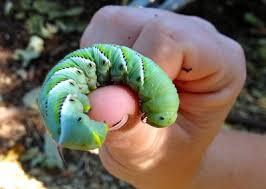
How to Identify and Control Tomato Hornworms
Have you ever noticed your tomato plants looking a little worse for wear, with chewed leaves and missing fruit? If so, you might be dealing with one of the most notorious garden pests: the tomato hornworm. These large, green caterpillars can wreak havoc on your garden in no time, leaving you frustrated and your plants in distress. But don’t worry—identifying and controlling tomato hornworms is entirely manageable with the right approach. In this guide, we’ll walk you through everything you need to know to protect your tomatoes and keep your garden thriving.
What Are Tomato Hornworms?
Tomato hornworms (Manduca quinquemaculata) are large, green caterpillars that are a common pest in vegetable gardens, particularly those with tomatoes, peppers, eggplants, and potatoes. These voracious feeders can grow up to 4 inches long and are known for their incredible appetite, devouring leaves, stems, and fruit as they go. While they may look intimidating due to their size and the horn-like projection on their rear end, they are the larval stage of the five-spotted hawk moth, a large moth that is active at night.
Lifecycle of the Tomato Hornworm
Understanding the lifecycle of the tomato hornworm is key to effectively managing this pest. The lifecycle begins when adult moths lay eggs on the undersides of leaves. Here’s a breakdown of each stage:
- Eggs: The adult hawk moth lays small, pale green eggs on the undersides of leaves. These eggs hatch within a week.
- Larvae (Caterpillars): Once hatched, the larvae, or hornworms, begin feeding on the plant. This stage lasts for about 3-4 weeks, during which they grow rapidly, molting several times.
- Pupae: After the larval stage, the hornworms drop to the soil and burrow underground to pupate. They remain in the pupal stage for several weeks to months, depending on the temperature.
- Adults: Finally, the pupae emerge as adult moths, ready to start the cycle over again by laying eggs.
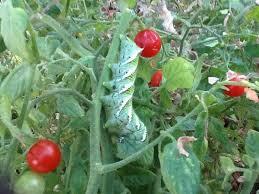
How to Identify Tomato Hornworms
Tomato hornworms are masters of camouflage, blending in seamlessly with the green foliage of tomato plants. This makes them challenging to spot, but there are several signs you can look for to detect their presence.
Visual Identification
- Size and Color: Tomato hornworms are bright green with white and black markings along their sides. They have a distinctive horn-like projection on their rear end, which gives them their name. Despite their size, they can be surprisingly hard to spot due to their coloring.
- Damage to Plants: One of the first signs of a hornworm infestation is defoliation—hornworms can strip a plant of its leaves quickly, leaving only stems behind. You may also notice holes in the leaves, chewed fruit, and dark green droppings (frass) on the ground or leaves.
- Droppings: The frass, or droppings, are another clear indicator. These look like small, dark green or black pellets and are usually found on leaves or around the base of the plant.
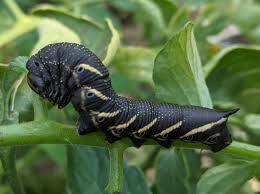
Using a Blacklight
If you’re having trouble spotting hornworms, try using a blacklight at dusk or night. The hornworms will glow under the light, making them much easier to find and remove.
Natural Predators and Beneficial Insects
One of the best ways to control tomato hornworms is to encourage their natural predators to take up residence in your garden. Many beneficial insects can help keep hornworm populations in check without the need for chemical interventions.
Parasitic Wasps
Parasitic wasps, particularly the braconid wasp, are highly effective at controlling hornworm populations. These tiny wasps lay their eggs on the hornworm’s body. When the eggs hatch, the larvae feed on the hornworm, eventually killing it. If you see a hornworm with white, rice-like cocoons on its back, leave it alone—these are the parasitic wasp cocoons, and they’ll help reduce the hornworm population.
Birds
Many bird species, such as robins and sparrows, are natural predators of hornworms. To attract birds to your garden, consider providing bird feeders, water sources, and nesting sites.
Other Beneficial Insects
Lacewings, ladybugs, and predatory beetles also prey on hornworms and their eggs. Encouraging a diverse insect population in your garden can help maintain a healthy balance and keep pest populations under control.
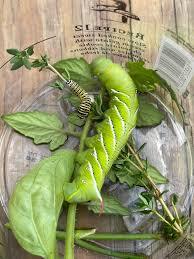
Manual Removal and Inspection
One of the simplest and most effective ways to control tomato hornworms is by manually removing them from your plants. This method is especially useful if you only have a small garden or a limited number of affected plants.
Handpicking Hornworms
- Early Morning or Late Evening: The best time to search for and remove hornworms is early in the morning or late in the evening when they are less active and easier to spot.
- Wear Gloves: Since hornworms are large and can be a bit intimidating, it’s a good idea to wear gloves when handling them.
- Dispose of Them: After removing the hornworms, you can drop them into a bucket of soapy water to kill them or feed them to backyard chickens if you have them.
Regular Inspections
Regularly inspect your tomato plants for signs of hornworm damage. Early detection is crucial, as it allows you to address the problem before the hornworms cause significant damage.
Organic and Chemical Control Methods
If natural predators and manual removal aren’t enough to control your hornworm problem, you may need to consider organic or chemical control methods. It’s important to use these treatments carefully to avoid harming beneficial insects and pollinators.
Organic Control Options
- Bacillus thuringiensis (Bt): Bt is a naturally occurring bacterium that is highly effective against caterpillars like tomato hornworms. When ingested, Bt paralyzes the hornworm’s digestive system, causing it to stop feeding and eventually die. Bt is safe for use around humans, pets, and beneficial insects, making it an excellent choice for organic gardeners.
- Neem Oil: Neem oil is a natural insecticide that works by disrupting the hornworm’s feeding and growth cycles. It can be applied as a foliar spray, but it’s most effective when used in combination with other control methods.
- Insecticidal Soaps: Insecticidal soaps can be used to control young hornworms before they become too large. These soaps work by disrupting the hornworm’s cell membranes, leading to dehydration and death.
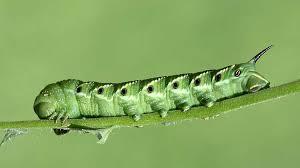
Chemical Control Options
- Synthetic Insecticides: If organic methods aren’t enough, synthetic insecticides may be necessary. However, they should be used as a last resort and with caution. Look for insecticides specifically labeled for use against caterpillars and follow the manufacturer’s instructions carefully.
- Spinosad: Spinosad is a natural insecticide derived from soil bacteria and is effective against hornworms. It works by causing nerve damage, leading to paralysis and death. While it’s generally safe for beneficial insects, it can harm pollinators, so use it carefully and avoid spraying it directly on flowers.
Preventing Tomato Hornworm Infestations
Preventing hornworms from taking over your garden in the first place is the best approach. By practicing good garden hygiene and taking preventative measures, you can reduce the likelihood of a hornworm invasion.
Crop Rotation
Crop rotation is a simple yet effective way to prevent hornworm infestations. By rotating your crops each season, you disrupt the life cycle of pests like hornworms, making it more difficult for them to establish a foothold in your garden.
Companion Planting
Companion planting involves growing certain plants together to deter pests or attract beneficial insects. Marigolds, basil, and dill are excellent companion plants for tomatoes, as they can help repel hornworms and attract beneficial insects.
- Marigolds: Marigolds emit a strong scent that repels many garden pests, including hornworms. Planting marigolds around your tomato plants can help keep these pests at bay.
- Basil: Basil is another great companion plant for tomatoes. Its strong aroma can confuse and deter hornworms, making it less likely that they’ll target your tomatoes.
- Dill: Dill attracts beneficial insects like parasitic wasps, which prey on hornworms. Planting dill near your tomatoes can help keep the hornworm population under control.
Soil Tilling
Tilling the soil at the end of the growing season can help reduce the number of hornworm pupae that survive the winter. By disturbing the soil, you expose the pupae to the elements, reducing the likelihood of a hornworm outbreak the following season.
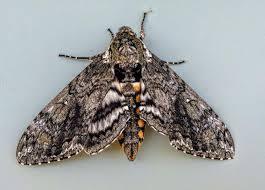
Dealing with Severe Infestations
In some cases, despite your best efforts, hornworm infestations can become severe. When this happens, it’s important to take swift action to prevent significant damage to your tomato plants.
Prune Affected Areas
If a plant is heavily infested, you may need to prune away the affected areas to prevent the hornworms from spreading to other parts of the plant or neighboring plants.
Use Row Covers
Row covers are lightweight fabrics that can be placed over your tomato plants to physically block pests from reaching them. While they’re typically used to prevent insect infestations early in the season, they can also be effective against hornworms during severe outbreaks.
Seek Professional Help
If you’re dealing with a particularly stubborn hornworm infestation that you can’t seem to control on your own, consider seeking help from a professional pest control service. They can assess the situation and recommend the most effective treatment options for your garden.
Keeping Your Tomato Plants Safe
Tomato hornworms may be a common garden pest, but with the right knowledge and tools, you can keep them from ruining your tomato harvest. By identifying these pests early, encouraging natural predators, and using a combination of manual, organic, and chemical controls, you can protect your tomato plants and enjoy a bountiful harvest.
Remember, the key to successful hornworm management is vigilance. Regularly inspecting your plants, maintaining good garden hygiene, and using preventative measures will go a long way in keeping these pesky caterpillars at bay. With a little effort, you can enjoy healthy, thriving tomato plants all season long.



